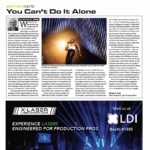We have all heard it before — “work smarter, not harder.” It has been drilled into our mind set since our school years. Why work harder than you need to, think about it for a moment and figure out the best way to do it. Thinking about it now, were our early years paving the way for us to be lazy? Not necessarily, it means to be a critical thinker, be aware of your surroundings and make the right/smarter choice.
In the entertainment business, we are constantly thinking on our feet, making quick decisions. When in the middle of a production, sometimes that has to happen in seconds. We have to be quick on our feet and make the best decision in order for the show to go on.
When I am in show mode, even in Editor mode, I am constantly looking for ways to work smarter and keeping the work flow running like a mint condition 1969 Ford Mustang, smooth and easy. Inevitably, something happens within the rig. There is always that one fixture that likes to act up and not work correctly. And wouldn’t you know, it is the one 30 feet in the air. Not easily accessible.
Of course, this always happens at the worst time — in the middle of a show or during a time-pressed rehearsal. Looks like we’ll be running a fixture down until break time. Then, as if on cue, the director or production manager comes up and asks why a light is out. They never want to hear the cause, just the solution. They never like hearing that it will have to wait.
We all know how important it is to have time with a dark stage to write cues and program looks. It’s frustrating when we have to cut into that valuable time, bringing up the house lights and bringing out a ladder so we can troubleshoot a faulty fixture. It might seem that this is just a curse that we have to live with, but we can minimize these intrusions into the work schedule if we can find a way to work smarter, not just harder.
The Magic of RDM
In recent years, I have been relying upon a protocol that makes some of these troublesome episodes disappear — RDM (Remote Device Management). I am making it sound like RDM is a magic genie that lives in our rig. But there’s no real sorcery involved; the RDM protocol is simply a new way to transfer information about a rig to the lighting console — first, via standard DMX cable, and more recently, involving network based protocols like sACN and ArtNet.
In 2006, ANSI E1.20 – 2006 was published and approved as a standard for the entertainment industry, formalizing the RDM protocol as a bi-directional, (half-duplex) communication system between the controller and the RDM devices on a lighting system. Over a standard DMX line, it is a un-directional protocol — the controller spits out a value for a DMX address, the fixture reads the value and does the corresponding change. With RDM, the fixture can “talk back” to the controller, but the controller has to send a request or GET command to the RDM device in order for the “talk back” to happen.
Here is the beauty part about RDM — the wealth of information you get from each device. Let’s say you have a long running show with a bunch of movers. Over time, the lamps will need to be changed. Before RDM, you could do one of two things. Wait for the lamp to blow, which could be at any moment, say, during a show. Or keep track of how long each lamp has been on and, before it hits its full lamp life expectancy, change out the lamps.
With RDM, the fixture can tell you that information. With some controllers, you can also set up an alert or reminder that goes off when a lamp hits 80 percent of its projected operating life — a good time to change out the lamp before it blows. It makes scheduling lamp change calls easier too!
Strategic lamp management is just one of many potential benefits of RDM; I’ve found that it can also streamline setup, patching and overall troubleshooting. In one case, an electrician addressed an RDM fixture incorrectly. The fixture was already in the air. Instead of pulling out a ladder, I was able to get things back on track, turning a 15-to-20-minute chore into a two-minute fix. That’s just one instance where RDM helped us work smarter, not harder.


